#Schleswig-Holstein architecture
Text

Glücksburg Castle – Magnus Weidemann
German, 1880–1967
Oil on masonite , 52 x 75.5 cm. 20.5 x 29.7 in.
#Magnus Weidemann#german artist#lake landscape#Schleswig-Holstein architecture#architecture#building#North Germany#Glücksburg Castle#renaissance castle
155 notes
·
View notes
Photo

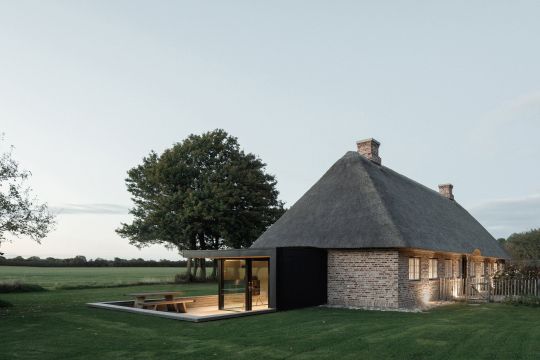

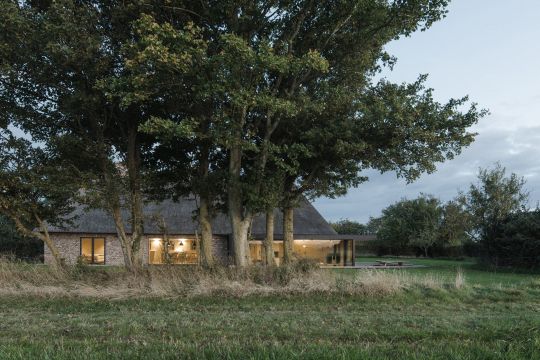

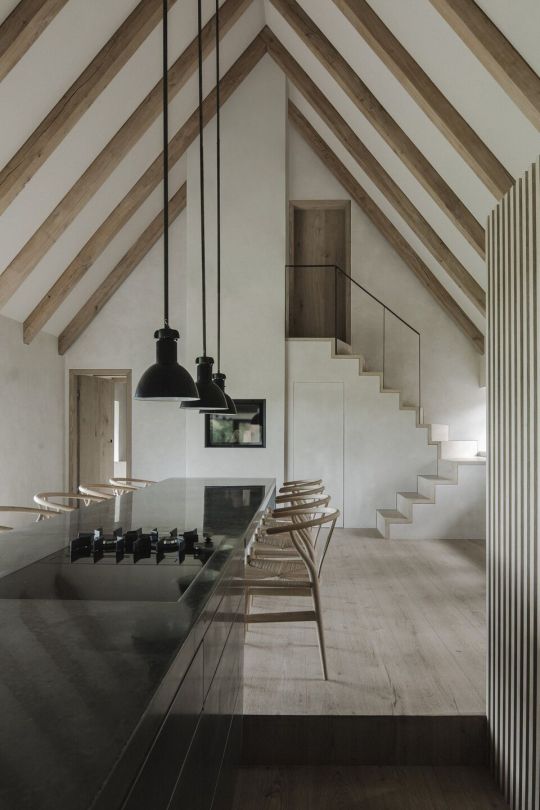


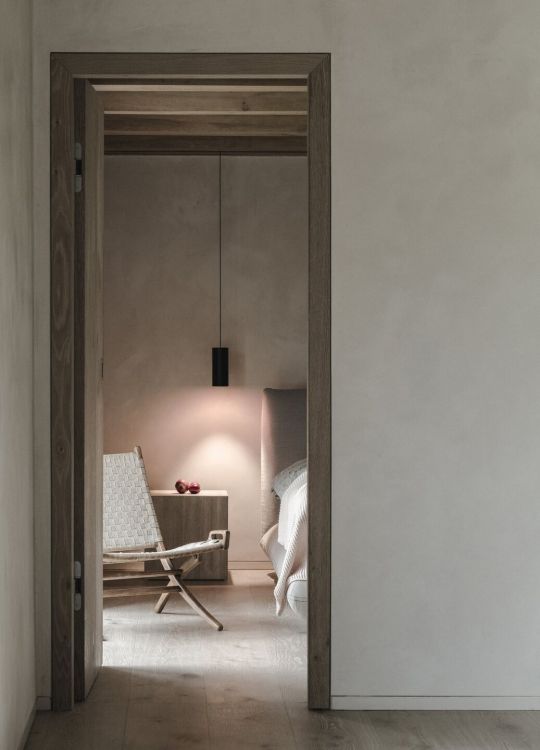

Nieby Crofters Cottage, Schleswig-Holstein, Germany,
Jan Henrik Jansen and Marshall Blecher,
Photographs by Jose Campos
#art#design#architecture#interiors#renovation#cottage#nieby crofter#germany#jan henrik jansen#jose campos#minimal#schleswig-holstein#luxurylifestyle#luxuryhomes#luxuryhouses#countryhouse#marshall blecher
253 notes
·
View notes
Text

Dom, Lübeck, Schleswig-Holstein, 1972.
#urban landscape#skyline#architecture#brick#cathedral#lübeck#schleswig-holstein#deutschland#1972#photographers on tumblr
20 notes
·
View notes
Photo

By Hrrbhn
Lübeck, Schleswig-Holstein, Germany
#curators on tumblr#germany#europe#travel#lubeck#schleswig holstein#western europe#architecture#hrrbhn
20 notes
·
View notes
Text










Schloss Hagen in Probsteierhagen
4 notes
·
View notes
Text

Schloss Ahrensburg, Germany.
https://commons.wikimedia.org/wiki/User:Holger.Ellgaard
#castle#ahrensburg#hamburg#schleswig holstein#medieval architecture#medieval#schloss#german history#germany#german#architektur#burg#fortress#fortifications#urban photography#wikipedia#deutsche geschichte#deutsches tumblr#deutschland#auf deutsch#allemagne#northern europe#european aristocracy#german aristocracy#german architecture#nobility#european royals#european royalty#european
0 notes
Text
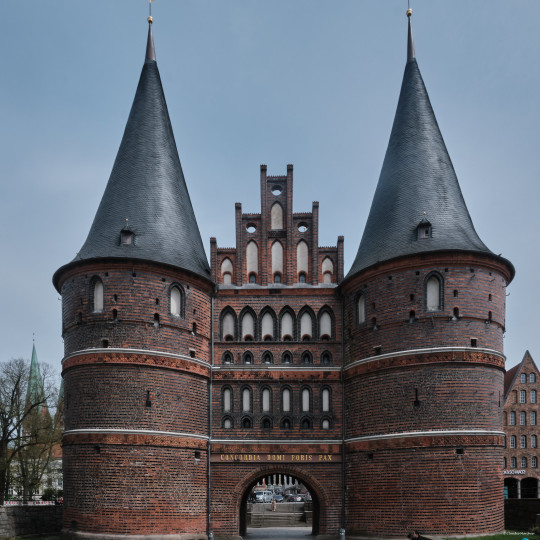


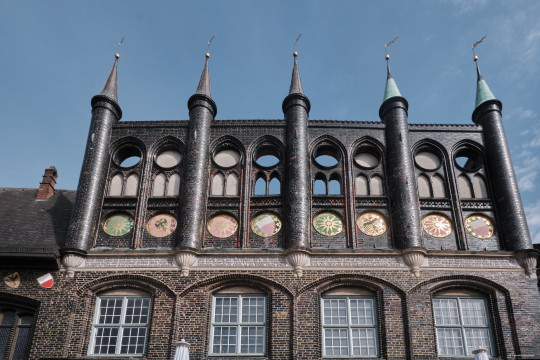

Lubecca (2) (3) (4) (5) by Claudio e Lucia Images around the world
#towers#gates#buildings#gothic architecture#brick gothic#churches#statues#houses#cobblestones#germany#lübeck#schleswig holstein
0 notes
Text


Kirche in Schönberg / Holstein
1 note
·
View note
Text
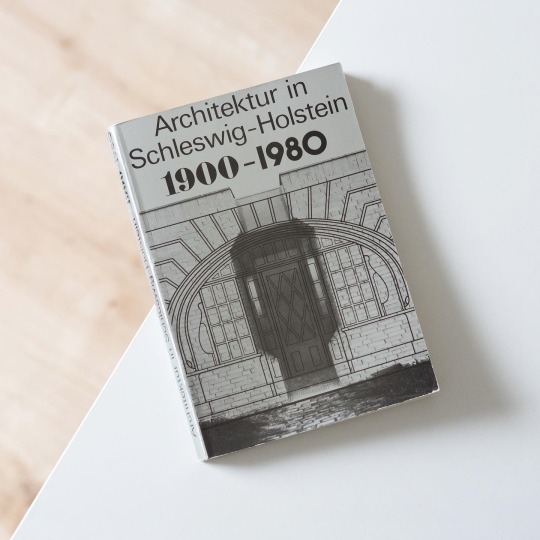
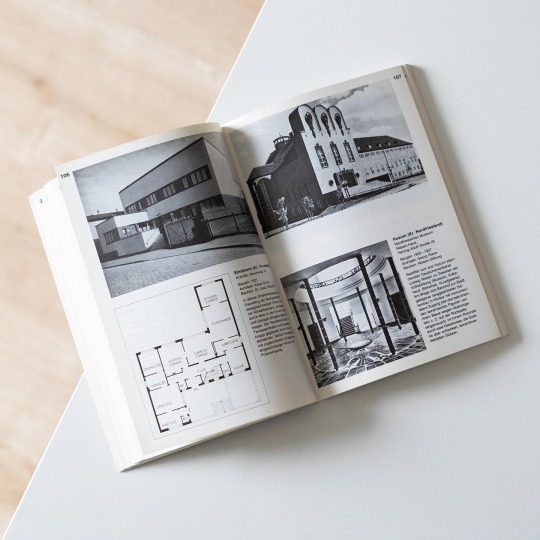
Germany’s northernmost Federal State Schleswig-Holstein to this day plays a rather peripheral role in modern architectural history, mainly due to the fact that the progressive developments of the 20th century haven’t gained a strong foothold in the largely agrarian and small-city setting of the territorial state. But on closer inspection it is possible to dig up local examples of exceptional architectural quality that demonstrate the architects’ ability to align tradition with modernity: one such example is Rudolf Schroeder’s work in Kiel, the state capital, who combined traditional brickwork with modern forms in a range of public buildings and schools before and after WWII. Due to its long history and easy availability the brick remained a staple in Schleswig-Holstein‘s architecture that during the interwar years inspired a number of very interesting buildings in the style of a restrained Brick Expressionism: although not as highly expressive and dramatic as e.g. its counterparts in the City of Hamburg local architects attuned expressive brick forms to existing contexts in a masterful and creative manner. From the 1960s onwards brick lost in importance and gave way to a modern architecture very much in tune with the overall stylistic developments in Germany.
In the present architectural guide, edited by Hartwig Beseler and published by Wachholtz in 1980, the progress of architecture in Schleswig-Holstein is illustrated by means of countless exemplary buildings built between 1900 and 1980. Each building is presented in a brief text, a plan and one or more photographs, a traditional but handy layout. Although the ravages of time might have is likely to have gnawed on the postwar buildings included the book nonetheless is a convenient vade mecum for architectural explorations in Schleswig-Holstein and a nice addition to my already large collection of architectural guides.
48 notes
·
View notes
Text
Deutschribing Germany
Landmarks
Germany is the third country in the world with the highest number of World Heritage Sites: fifty-one in total, of which forty-eight are cultural and three are natural.

Aachen Cathedral
The Aachen Cathedral is a Roman Catholic church in Aachen, North Rhine-Westphalia. It is one of the oldest cathedrals in Europe and was consecrated in 805. Emperor Charlemagne was buried there.
The cathedral has two distinct architectural styles and small portions of a third. The core is Carolingian-Romanesque, the choir was constructed in the Gothic style, and the area around the throne is Ottonian.
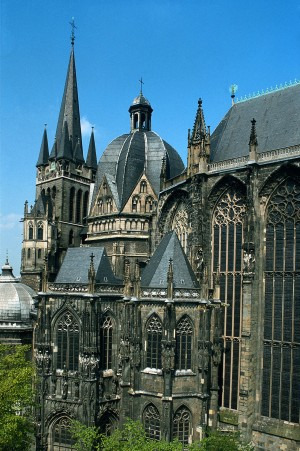
Abbey and Altenmünster of Lorsch
The Lorsch Abbey is a former imperial abbey in Lorsch, Hesse. It was founded in 764 and was one of the most renowned monasteries of the Carolingian Empire. Although in a ruined state nowadays, its remains are among the most important pre-Romanesque-Carolingian style.
The abbey combines the Roman triumphal arch (arch-shaped passageways and half-columns) with the vernacular Teutonic heritage (baseless triangles of the blind arcade and polychromatic masonry).

Ancient and Primeval Beech Forests of the Carpathians and Other Regions of Europe
The Ancient and Primeval Beech Forests of the Carpathians and Other Regions of Europe is a transnational serial nature site that includes forests in Albania, Austria, Belgium, Bulgaria, Croatia, Germany, Italy, Romania, Slovakia, Slovenia, Spain, and Ukraine.
It encompasses 94 forests of European beech, which in many cases have grown without interference since the last ice age. Those in Germany are located in Brandenburg, Hesse, Mecklenburg-Vorpommern, and Thuringia.

Archaeological Border complex of Hedeby and the Danevirke
Hedeby was an important Danish Viking Age trading settlement between the 8th and 11th centuries, now in Busdorf, Schleswig-Holstein. It was rediscovered in the late 19th century.
The Danevirke or Danework is a system of Danish fortifications in Schleswig-Holstein initiated in 650 and expanded during the Viking Age and High Middle Ages.

Bauhaus and its Sites in Weimar, Dessau and Bernau
Bauhaus and its Sites in Weimar, Thurngia; Dessau-Roßlau, Saxony-Anhalt, and Bernau bei Berlin, Brandenburg, comprises six separate sites associated with the Bauhaus art school, which was in operation between 1919 and 1933.
The buildings are fundamental representatives of Classical Modernism and Art Nouveau. Some of them were built as social housing, others operated as schools, and the rest of them were residential buildings.

Bergpark Wilhelmshöhe
Bergpark Wilhelmshöhe is a landscape park in Kassel, Hesse. It is the largest European hillside park and the second-largest park on a hill slope in the world. Construction began in 1689 and lasted 150 years.
The park has Baroque buildings and unique fountains and water features. At the summit stands the Hercules monument, a 40-meter-high pyramid with an 8.5 meter bronze statue of Hercules.

Berlin Modernist Housing Estates
The Berlin Modernist Housing Estates site comprises six separate subsidized housing estates in Berlin. It dates from the Weimar Republic (1919-1933).
The estates are examples of the building reform movement that contributed to improving housing and living conditions of people and also provide exceptional examples of new urban and architectural typologies, as well as technical and aesthetic innovations.

Carolingian Westwork and Civitas Corvey
The Princely Abbey of Corvey is a former Benedictine abbey consecrated in 844 and located in Höxter, North Rhine-Westphalia. It was one of the self-ruling princely abbeys of the Holy Roman Empire.
An example of Carolingian architecture, it is the oldest surviving example of a westwork, whose inside contains the only known wall paintings of ancient mythology with Christian interpretation in Carolingian times.

Castles of Augustusburg and Falkenlust at Brühl
The Ausgustusburg and Falkenlust Palaces form a historical building complex in Brühl, North Rhine-Westphalia. The buildings are connected by the spacious gardens of the Schlosspark.
Built in the early 18th century, the palaces and gardens are masterpieces of early Rococo architecture. They are now used as a venue for concerts.

Caves and Ice Age Art in the Swabian Jura
The Caves and Ice Age Art in the Swabian Jura are a collection of six caves in the Swabian Alps, in Baden-Württemberg, which were used by Ice Age humans for shelter about 33,000 to 43,000 years ago.
Within the caves were found the oldest non-stationary works of human art in the form of carved animal and humanoid figurines, in addition to the oldest musical instruments ever found.

Classical Weimar
Classical Weimar consists of eleven sites in and around Weimar, Thuringia. The city was a cultural center of the Enlightenment during the 18th and 19th centuries, where many notable writers and philosophers, including Christoph Martin Wieland, Friedrich Schiller, John Gottfried Herder, and Johann Wolfgang von Goethe, lived and participated in the Weimar Classicism movement.
It includes the church of St. Peter and Paul, Duchess Anna Amalia Library, Goethe's house, Herders residence, the historical cemetery, Park an der Ilm, Schiller's house, Schloss Belvedere, Schloss Ettersburg, Schloss Weimar, Tiefurt House, Wilhelm-Ernst-Gymnasium, and Wittumspalais.

Collegiate Church, Castle, and Old Town of Quedlinburg
Quedlinburg was an influential and prosperous trading center during the early Middles Ages and a center of influence under the Ottonian dynasty.
Quedlinburg Abbey was a house of secular canonesses in Quedlinburg, Saxony-Anhalt. It was founded in 936 on the initiative of Saint Mathilda, the widow of King Henry the Fowler, as his memorial. The castle, abbey, church, and surrounding buildings are masterpieces of Romanesque architecture.

Cologne Cathedral
The Cologne Cathedral is a Catholic cathedral in Cologne, North Rhine-Westphalia. Construction began in 1248 but was halted in 1560; the cathedral was not completed until 1880.
It is a renowned monument of Gothic architecture and the largest Gothic church in Northern Europe, with the second-tallest spires. It is also the third-tallest church in the world.

Darmstadt Artists' Colony Mathildenhöhe
The Darmstadt Artists' Colony refers to a group of Jugendstil artists as well as to the buildings in Mathildenhöhe in Darmstadt, Hesse, where the artists lived in the 19th and 20th centuries.

They were financed by patrons and worked together with other members of the group with similar artistic tastes.
Erzgebirge/Krušnohoří Mining Region
The Ore Mountains—Erzgebirge in German and Krušnohoří in Czech—lie along the Czech-German border in Bohemia and Saxony, respectively, and the site is shared between the Czech Republic and Germany.

The region was the setting of the earliest stages of the early transformation of mining and metallurgy from a craft to a large-scale industry. As a result, mining directly shaped the landscape and the habitats of plants and animals.
Fagus Factory in Alfeld
The Fagus Factory is a shoe last factory in Alfeld on the Leine, Lower Saxony. It is an important example of early modern architecture.

The factory was commissioned by Carl Benscheidt, who wanted a radical structure that expressed the company's break from the past. It was built between 1911 and 1913.
Frontiers of the Roman Empire
Limes is the term used to refer to the Germanic border defense or delimiting system marking the borders of the Roman Empire and separating the empire from the unsubdued Germanic tribes between the years 83 and 260.
The Limes Germanicus are the fortifications that bounded the ancient Roman provinces of Germania Inferior, Germania Superior, and Raetia, in modern-day southwestern North Rhine-Westphalia and southwestern and southern Germany. Their total length was 568 km, and they included sixty forts and 900 watchtowers.
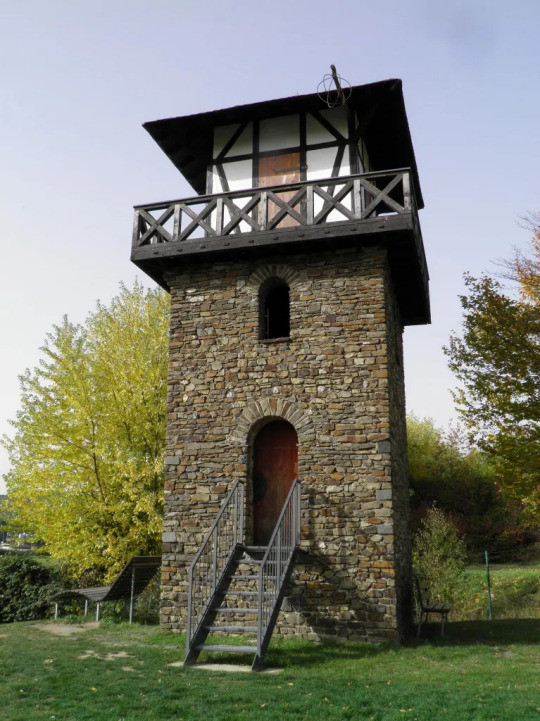
Frontiers of the Roman Empire in Bavaria
The Danubian Limes refers to the Roman military frontier along the Danube in Bavaria, as well as Austria, Bulgaria, Croatia, Hungary, Romania, Serbia, and Slovakia.
The border was reinforced with watchtowers, legion camps, and forts built around the first century. A Roman road, the Danube Way, was laid along the limes.

Garden Kingdom of Dessau-Wörlitz
The Dessau-Wörlitz Garden Realm is a cultural landscape between Dessau and Wörlitz in Saxony-Anhalt. It was created in the late 18th century and is one of the largest English parks in continental Europe.

It was designated as a world heritage site because of its exceptional landscape design and testimony to the ideals of the Enlightenment Age.
Great Spa Towns of Europe
The Great Spa Towns of Europe is a transnational site that includes eleven spa towns across several European countries, namely, Austria, Belgium, Czech Republic, France, Germany, Italy, and the United Kingdom.
Those in Germany are Bad Ems, Rhineland-Palatinate; Baden-Baden, Baden-Württemberg, and Bad Kissingen, Bavaria. All the spa towns were developed around natural mineral water springs.

Hanseatic City of Lübeck
The Hanseatic City of Lübeck, located in Schleswig-Holstein, is the second-largest city on the German Baltic coast. It was founded before 819 by Polabian Slavs and became the cradle and capital city of the Hanseatic League.
Nicknamed the "City of Seven Towers", its historic old town includes five Protestant churches with seven towers: the Lübeck Cathedral, St. Giles's, St. Jacob's, St. Mary's, and St. Peter's, as well as the Burgkloster, the Koberg site, the town hall, and the market square.

Historic Centers of Stralsund and Wismar
The Hanseatic City of Stralsund is located in Mecklenburg-Western Pomerania and is the oldest city in Pomerania. The Strelasund Crossing connects the city with Rügen, the largest island of Germany. Its old town was inscribed as a UNESCO World Heritage Site alongside Wismar because of its Brick Gothic buildings and importance in the Hanseatic League.
The Hanseatic City of Wismar is also located in Mecklenburg-Western Pomerania. Its historical old town includes the churches of St. George's, St. Mary's, and St. Nicholas's.
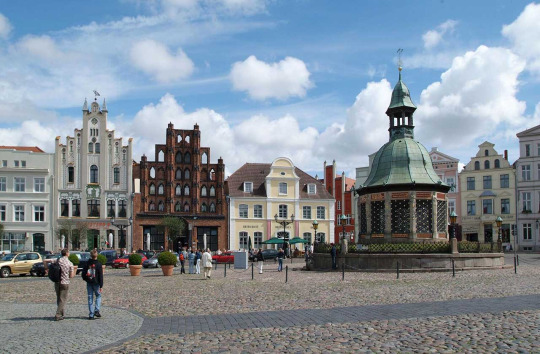
Luther Memorials in Eisleben and Wittenberg
Eisleben, in Saxony-Anhalt, was the hometown of Martin Luther, and he even preached his last sermon and died there. His Birth and Death houses are a UNESCO World Heritage Site. The town was first mentioned in the late 10th century.
Wittenberg is also famous for its close connection with Luther, as he lived in the Augustinian monastery. It was also one of the most powerful cities in the Holy Roman Empire as the seat of the Elector of Saxony.

Margravial Opera House Bayreuth
The Margravial Opera House is a Baroque opera house in Bayreuth, Bavaria. It was constructed according to the plans designed by the French architect who built the court of Hohenzollern margrave Frederick of Brandenburg-Bayreuth.
The façade was inspired by the Place Vendôme in Paris and has large Corinthian columns. A balustrade is stretched across the façade, with sculptures of Apollo, Minerva, and six Muses placed atop.

Maulbronn Monastery Complex
The Maulbronn Monastery is a former Cistercian abbey and ecclesiastical state in Maulbronn, Baden-Württemberg.

Founded in 1147, the complex is surrounded by turreted walls and a tower gate. Today it houses the town hall and a police station. The monastery contains an Evangelical seminary and a boarding school.
Messel Pit Fossil Site
The Messel pit is a quarry near Messel, in Hesse. Before it fell into disuse, bituminous shale was mined there. Besides its mineral significance, it also has significant geological and scientific importance due to the abundance of well-preserved fossils and diversity of plants and animals found there.

The site almost became a landfill, but strong local resistance stopped these plans and the site was declared a World Heritage Site. Since then, discoveries about the early evolution of mammals and birds are still being made.
Mines of Rammelsberg, Historic Town of Goslar and Upper Harz Water Management System
The Rammelsberg is a mountain south of Goslar, Lower Saxony, where an important silver, copper, and lead mine is located. Before its closure in 1988, it was the only mine still working continuously for over 1,000 years.
Goslar's political importance for the Holy Roman Empire and its testimony to the history of ore mining contributed to making them a UNESCO World Heritage Site. The Upper Harz Water Regale is a system of dams, reservoirs, and ditches built between the 16th and 19th centuries to store the water that drove the water wheels of the mines, including those in Rammelsberg.

Monastic Island of Reichenau
The Reichenau Island is located in Lake Constance, Baden-Württemberg. It is connected to the mainland by a causeway and a low road bridge.
In 724, the first monastery was built on the island, and Reichenau became an influential religious, cultural, and intellectual center. The Reichenau Abbey was one of the most significant monasteries in the Frankish Empire.

Museum Island, Berlin
The Museum Island in Berlin is a museum complex on the northern part of the Spree Island. It was built between 1830 and 1930 by order of the Prussian kings.
The island consists of the Altes Museum (old museum), Neues Museum (new museum), Alte Nationalgalerie (old national gallery), the Bode-Museum, and the Pergammonmuseum, as well as the Berlin Cathedral.
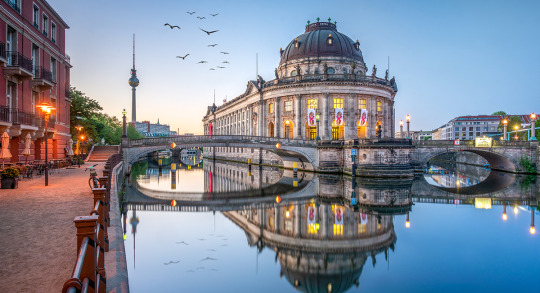
Muskauer Park/Park Mużakowski
The Muskau Park—Muskauer Park in German and Park Mużakowski in Polish—is a landscape park in Upper Lusatia, a region between Germany (Saxony) and Poland.
The site forms the largest English gardens in Central Europe and was laid out from 1815 onward. Its utopian design incorporates both native plants and the nearby town.
Naumburg Cathedral
The Naumburg Cathedral is located in Saxony-Anhalt. It dates from the 13th century and is a renowned landmark of the German Romanesque.
The west choir, the donor portrait statues of the twelve founders, and the rood screen are significant early Gothic monuments.
Old Town of Regensburg with Stadtamhof
Regensburg, in Bavaria, was an imperial Roman river fort and the political, economic, and cultural center of the surrounding region.
Its medieval center was made a World Heritage Site because of its well-preserved architecture, being the biggest medieval city north of the Alps, and historical importance for assemblies during the Holy Roman Empire.
Palaces and Parks of Potsdam and Berlin
The Palaces and Parks of Potsdam and Berlin site is a group of palace complexes and landscaped gardens in the Havelland region around Berlin and Potsdam.
Among others, the site includes the Palace and Park of Sanssouci, Neuer Garten (New Garden), Marmorpalais (Marble Palace), Cecilienhof Palace, Glienicke Palace, Park Glienicke, Nikolskoe log house, Pfaueninsel (Peacock Island), and Jagdschloß Glienicke (Glienicke hunting lodge).
Pilgrimage Church of Wies
The Pilgrimage Church of Wies is an oval Rococo church located in the foothills of the Alps in the town of Steingaden, Bavaria. It was built in the late 1740s by the Zimmermann brothers after a miracle allegedly happened there.
In 1738, tears were seen on a wooden figure of Christ at the Column. This resulted in a pilgrimage rush to see the sculpture, which led to the construction of a small chapel to house the statue. The chapel was soon expanded due to the large number of pilgrims it attracted.
Prehistoric pile dwellings around the Alps
The prehistoric pile dwellings around the Alps are a series of prehistoric stilt houses settlements in the Alps built between 5,000 and 500 BCE on the edges of lakes, rivers, or wetlands.
The UNESCO site includes 111 dwellings in Switzerland (56), Italy (19), Germany (18), France (11), Austria (5), and Slovenia (2). Excavations conducted at some of the sites have yielded important evidence regarding prehistoric life.
Roman Monuments, Cathedral of St. Peter and Church of Our Lady in Trier
The Roman Monuments, Cathedral of St. Peter and Church of Our Lady in Trier, Rhineland-Palatinate, demonstrate the political, economic, and historical importance of Trier in the Roman Empire.
The site includes the Aula Palatina, Barbara Baths, Church of Our Lady, High Cathedral of Saint Peter, Igel Column, Imperial Baths, Moselle Bridge, and Porta Nigra.
ShUM cities of Speyer, Worms and Mainz
The ShUM cities site refers to three Jewish communities in Rhineland-Palatinate: Shpira (Speyer), Warmaisa (Worms), and Magenza (Mainz). They were cultural centers of Jewish scholarship and of great importance for Ashkenazi Judaism.
Speyer contains some of the oldest and best-preserved Jewish buildings in its Jewish courtyard, while Worms has the oldest surviving in situ cemetery in Europe. Unfortunately, the city of Mainz, like many other places around the world, was the site of persecution and massacres against Jewish people.
Speicherstadt and Kontorhaus District
The Speicherstadt ("City of Warehouses") and Kontorhaus District are located in Hamburg. The Speicherstadt, where buildings stand on oak-pile foundations, is the largest warehouse district in the world. An example of Neo-Gothic and modernist architecture, the district was built as a free zone to transfer goods without paying customs.
The Kontorhaus District is the southeastern part of the old town. It is characterized by large office buildings in the style of Brick Expressionism. The area is densely built-up with many narrow alleys.
Speyer Cathedral
The Imperial Cathedral Basilica of the Assumption and St. Stephen is located in Speyer, Rhineland-Palatinate. The cathedral was built in the 11th century and features a triple-aisled vaulted basilica of red sandstone.
It is the largest Romanesque church in the world and is the burial site of several Salian, Hohenstaufen, and Habsburg emperors and kings.
St. Mary's Cathedral and St. Michael's Church at Hildesheim
The Cathedral of the Assumption of Mary is a medieval Roman Catholic cathedral in Hildesheim, Lower Saxony. It was built between 1010 and 1020 in the Romanesque style.
The Church of St. Michael is an early-Romanesque church in Hildesheim. Built in the 11th century, it is now a shared church, the main church being Lutheran and the crypt being Roman Catholic.
The Architectural Work of Le Corbusier, an Outstanding Contribution to the Modern Movement
The Architectural Work of Le Corbusier site consists of seventeen Modernist buildings in three continents by architect Le Corbusier.
The Weissenhof Estate is a housing estate in Stuttgart, Baden-Württemberg, and one of Le Corbusier's designs. It was built for an exhibition to showcase modern architecture's aspiration to provide cheap, simple, efficient, and good-quality housing.
Town Hall and Roland on the Marketplace of Bremen
The Bremen City Hall is one of the most important examples of Brick Gothic and Weser Renaissance architecture in Europe. Built in the 15th century, it is located on the market square.
Directly in front of it is the statue of Roland, which depicts the paladin of the first Holy Roman Emperor Charlemagne and hero of the Battle of Roncevaux Pass. It was erected in 1404 and the oldest surviving example.
Town of Bamberg
Bamberg is a town in Bavaria that dates back to the 9th century. It was a key link with the Slavs, especially those of Pomerania and Poland, and was briefly the center of the Holy Roman Empire.
Its medieval streets and buildings and historical significance were behind its designation as a UNESCO World Heritage Site.
Upper Middle Rhine Valley
The Upper Middle Rhine Valley or Rhine Gorge is a 65 km section of the Rhine between Koblenz and Rüdesheim in Rhineland-Palatinate and Hesse.
The rocks that form the landscape were laid down during the Paleozoic era and are known as Rhenish Facies, a type of fossil-bearing sedimentary rock mainly consisting of slate.
Völklingen Ironworks
The Völklingen Ironworks is a former blast-furnace complex in Völklingen, Saarland. Pig or crude iron production occurred at the site between 1882 and 1986.
It is one of the few intact ironworks surviving in Europe and North America and a testimony to ferrous metallurgy and the Industrial Revolution.
Wadden Sea
The Wadden Sea is an intertidal zone in the southeastern part of the North Sea, which borders Bremen, Hamburg, Lower Saxony, and Schleswig-Holstein.
It lies between northwestern continental Europe and the low-lying Frisian Islands, forming a shallow body of water with tidal flats and wetlands. The site has a high biological diversity and is an important area for breeding and migrating birds.
Wartburg Castle
The Wartburg is a medieval castle in Eisenach, Thuringia. It was the home of St. Elisabeth of Hungary and the place where Martin Luther translated the New Testament.
The castle's structures date from the 12th through 15th centuries, but the interior only goes back to the 19th century. It was an important inspiration for the Neuschwanstein Castle.
Water Management System of Augsburg
The Water Management System of Augsburg is located in the city of Augsburg, Bavaria, which is one of Germany's oldest cities, founded by the Romans.
The city's water management system has unique medieval canals and water towers and is testimony to the development of hydraulic engineering.
Würzburg Residence with the Court Gardens and Residence Square
The Würzburg Residence is a palace in Würzburg, Bavaria, whose interiors are masterworks of Baroque and Rococo architecture and art, including the largest fresco in the world.
Built in the 18th century, the residence includes large gardens in the Baroque and English garden styles.
Zollverein Coal Mine Industrial Complex
The Zollverein Coal Mine Industrial Complex is a former industrial site in Essen, North Rhine-Westphalia. The first mine was founded in 1847 and the last one closed in 1986.
The two parts of the site ranked among the largest of their kinds in Europe and were built in the New Objectivity style.
12 notes
·
View notes
Text
The 16 States of Germany: Exploring the Diversity and Unity
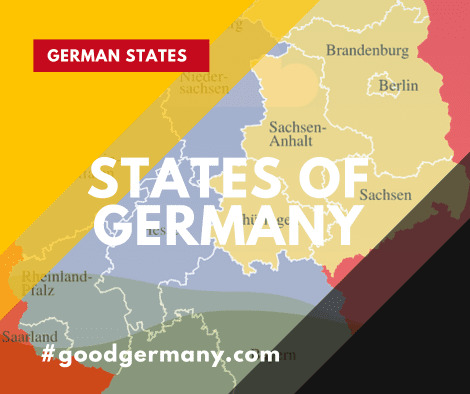
Germany, renowned for its rich history, cultural heritage, and economic prowess, is a country that consists of 16 distinct states, each with its own unique character and charm. From the bustling metropolitan areas to the serene countryside landscapes, Germany showcases a harmonious blend of modernity and tradition. Let's embark on a journey to discover the 16 states that contribute to the vibrant tapestry of this remarkable nation.
Table of Contents
- Introduction
- Schleswig-Holstein: Where Land Meets Sea
- Bavaria: A Tale of Traditions
- Berlin: The Heart of Modernity
- Baden-Württemberg: Innovation and Greenery
- Saxony: Where History and Culture Converge
- Hamburg: Gateway to the World
- North Rhine-Westphalia: Industrious and Dynamic
- Lower Saxony: Nature's Abode
- Hesse: Where Urbanity Meets Heritage
- Rhineland-Palatinate: Vineyards and Beyond
- Brandenburg: Castles and Lakes
- Thuringia: Enchanting Landscapes
- Mecklenburg-Vorpommern: Coastal Beauty
- Saxony-Anhalt: Of Art and Architecture
- Saarland: Small yet Significant
- Bremen: A Tale of Two Cities
- Conclusion
- FAQs
- What is the significance of Germany's division into states?
- Which state is known for its Oktoberfest celebrations?
- What makes Berlin a unique capital city?
- Which state is famous for its automotive industry?
- Are the states of Germany culturally diverse?
Introduction
Germany's federal structure comprises 16 states, often referred to as Bundesländer. This decentralized system empowers each state to have its own constitution, government, and educational policies while collaborating on national matters.
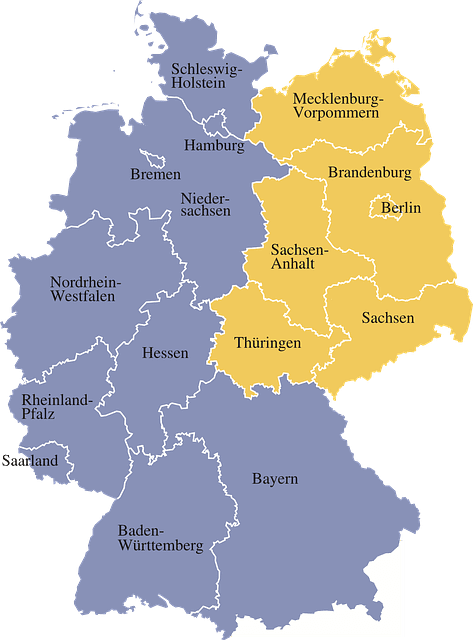
Schleswig-Holstein: Where Land Meets Sea
Nestled between the North Sea and the Baltic Sea, Schleswig-Holstein is renowned for its stunning coastline, charming villages, and maritime heritage. Visitors are drawn to its pristine beaches, and the iconic port city of Kiel hosts the renowned Kiel Week sailing event.
Bavaria: A Tale of Traditions
Bavaria, famous worldwide for its traditional culture, picturesque landscapes, and iconic Oktoberfest, embraces both its history and innovation. The state boasts fairytale castles like Neuschwanstein and a thriving technology sector.
Berlin: The Heart of Modernity
The capital city, Berlin, stands as a symbol of unity and progress. Rich in history, it houses iconic landmarks like the Brandenburg Gate, while also being a haven for artists, entrepreneurs, and diverse cultures.
Baden-Württemberg: Innovation and Greenery
Known for its high standard of living, Baden-Württemberg combines technological innovation with natural beauty. It's home to global automobile companies and the enchanting Black Forest region.
Saxony: Where History and Culture Converge
Saxony's historic cities like Dresden and Leipzig are cultural treasures. With a legacy of classical music, ornate architecture, and cutting-edge research, Saxony is a dynamic hub of art and innovation.
Hamburg: Gateway to the World
Hamburg, a bustling port city, has a maritime legacy that extends to its modernity. Its famous harbor, impressive architecture, and vibrant nightlife make it a global hub of trade and culture.
North Rhine-Westphalia: Industrious and Dynamic
This economic powerhouse, known as NRW, encompasses major cities like Cologne and Düsseldorf. With a rich industrial history, it's a melting pot of creativity, business, and diverse communities.
Lower Saxony: Nature's Abode
Lower Saxony is blessed with natural beauty, boasting the Wadden Sea National Park and serene landscapes. Hannover, its capital, seamlessly blends urban amenities with a tranquil environment.
Hesse: Where Urbanity Meets Heritage
In Hesse, the metropolis of Frankfurt contrasts with charming historic towns like Heidelberg. It's a financial center with a touch of tradition, offering a balanced urban and rural experience.
Rhineland-Palatinate: Vineyards and Beyond
This wine-producing region showcases medieval architecture, particularly in its capital, Mainz. Rhineland-Palatinate's rolling vineyards, combined with cultural heritage, make it a visual and culinary delight.
Brandenburg: Castles and Lakes
Surrounding Berlin, Brandenburg is a nature lover's paradise. Its serene lakes, picturesque countryside, and a plethora of castles create an idyllic escape from the urban bustle.
Thuringia: Enchanting Landscapes
Thuringia's dense forests and charming towns inspired poets like Goethe and Schiller. Erfurt and Weimar are cultural hotspots, offering insights into Germany's intellectual history.
Mecklenburg-Vorpommern: Coastal Beauty
The Baltic Sea coastline defines this state, where seaside resorts and historic towns abound. Mecklenburg-Vorpommern is a haven for water sports enthusiasts and those seeking tranquility.
Saxony-Anhalt: Of Art and Architecture
Home to the Bauhaus movement, this state celebrates modern art and design. Saxony-Anhalt's cultural offerings extend to historic Magdeburg and the scenic Harz mountains.
Saarland: Small yet Significant
Saarland's picturesque landscapes and unique blend of French and German influences make it an intriguing destination. Its industrial heritage and natural beauty create a distinctive identity.
Bremen: A Tale of Two Cities
Bremen and Bremerhaven, two cities within this smallest state, offer maritime history and modern innovation. Bremen's UNESCO-listed market square and the German Emigration Center in Bremerhaven provide diverse experiences.
Conclusion
Germany's 16 states showcase a harmonious blend of traditions, innovation, nature, and culture. Each state contributes to the nation's identity, reminding us of the diversity that unites this remarkable country.
FAQs
- What is the significance of Germany's division into states? Germany's federal structure empowers states with autonomy while fostering unity on a national level.
- Which state is known for its Oktoberfest celebrations? Bavaria is renowned for hosting the world-famous Oktoberfest, a celebration of Bavarian culture.
- What makes Berlin a unique capital city? Berlin is a melting pot of art, history, and modernity, reflecting Germany's complex history and contemporary vitality.
- Which state is famous for its automotive industry? Baden-Württemberg, with cities like Stuttgart, is a hub of automobile manufacturing and technological innovation.
- Are the states of Germany culturally diverse? Yes, each state has its own distinct culture, traditions, and characteristics, contributing to Germany's rich diversity.
Read the full article
3 notes
·
View notes
Photo

A stomach filled with a delicious meal 🍲, makes every mountain ⛰️ feel like a valley. Follow @bnw.inspirations for more...🤍 . . . . . #bnwphotography #blackandwhitephotography #bnw_greatshots #bnw_captures #bnw_waterdrama #architecture #architecturephotography #bnw_of_our_world #hamburg #geesthacht #germany #bnwsouls #noiretblanc #noiretblancphoto #travelnoire #travelphotography #blackculture #compositephotography #photographyinspiration #simplephotography #gophotography #foodies #foodlover #dönerkebab #döner #foodstagram #photographerofinstagram (hier: Stadt Geesthacht, Schleswig-Holstein, Germany) https://www.instagram.com/p/ClmEQgwMkpA/?igshid=NGJjMDIxMWI=
#bnwphotography#blackandwhitephotography#bnw_greatshots#bnw_captures#bnw_waterdrama#architecture#architecturephotography#bnw_of_our_world#hamburg#geesthacht#germany#bnwsouls#noiretblanc#noiretblancphoto#travelnoire#travelphotography#blackculture#compositephotography#photographyinspiration#simplephotography#gophotography#foodies#foodlover#dönerkebab#döner#foodstagram#photographerofinstagram
2 notes
·
View notes
Text
Thursday Thrill Festival Frenzy: January's Global Extravaganza!
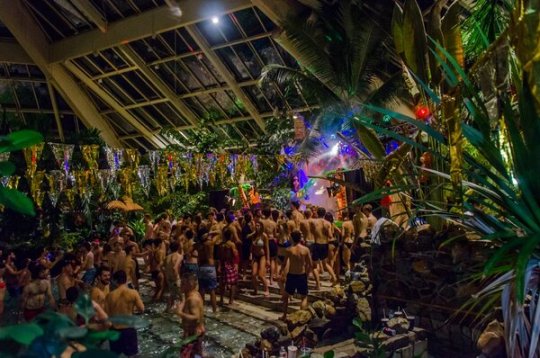
Get ready for a January filled with festival magic! From indie film marvels to rhythmic beats and the spirited Burns Night, our listicle is your guide to the world's most vibrant festivals. Join the celebration as we unveil the cultural brilliance that makes January a global festival haven!
Sundance Film Festival
18 - 28 Jan
Salt Lake City, USA
Celebrating independent cinema on a global scale, the Sundance Film Festival stands as the epitome of Indie film festivals. Established in Utah with the influence of Robert Redford, whose character in "Butch Cassidy and the Sundance Kid" inspired the festival's name, it serves as a platform for discovering emerging talents across various categories like full-length films, documentaries, and shorter pieces.
For more>https://festival.sundance.org/
Wolfkop Weekender
18 - 22 Jan
Cape Town, South Africa
Nestled in the picturesque Citrusdal Valley, Wolfkop Weekender is a well-kept secret within the South African festival circuit. With a 2,000-capacity audience, this four-day event marks its tenth anniversary, blending big names such as Canadian composer Frivolous and Charles Webster, a collaborator with Burial, alongside over 40 talented local acts. The event takes place at an idyllic riverside location, striking a balance between future-forward programming and paying homage to its rich history.
For more> https://www.wolfkopweekender.co.za/
Closer Music Festival
19 - 21 Jan
Paris, France
Held at Lafayette Anticipations, an architecturally dynamic venue designed by Rem Koolhaas, Closer Music Festival transforms its ever-changing space into a canvas for experimentalism and intimacy. The festival, spanning three days, features live performances, audiovisual installations, and cross-genre collaborations aimed at provoking new shifts in artistic perspectives. With acts like Osheyack and Marina Herlop, the festival promises a deeply cerebral experience against the backdrop of Paris's creative landscape.
NACHTIVILLE
19 - 22 Jan
Schleswig-Holstein, Germany
Defying the traditional notion of a quiet January in the northern hemisphere, NACHTIVILLE emerges as a beacon of festival excitement. Hosted at Weissenhäuser Strand on Germany's Baltic coast, this event by the creators of Nachtdigital. It takes place in a family-friendly holiday park. Boasting a diverse lineup across five stages, from established favorites like Job Jobse and Gerd Janson to newcomers like Acidfinky and Interplanetary Criminal, NACHTIVILLE caters to various tastes. Whether reveling in big-room energy at THE HALL or enjoying the intimacy of the wooden hut CHALET. The festival promises a unique experience.
For more>https://ra.co/events/1761508
Burns Night Burns Supper Festival
25 Jan
Scotland, UK
Embraced with fervor throughout Scotland and by Scottish communities worldwide. The Burns Night Burns Supper Festival pays tribute to the legendary poet laureate, Robert "Rabbie" Burns. He born on January 25, 1759. The celebration involves a rich tapestry of traditions, including heartfelt toasts, especially dedicated to the iconic haggis, accompanied by the donning of kilts, spirited dancing, and the indulgence in Scotland's renowned whisky. The pinnacle of the evening is marked by a soul-stirring rendition of Burns' most celebrated poem, "Auld Lang Syne," creating a cultural mosaic that resonates with the essence of Scottish heritage and literary brilliance.Foe more> https://www.visitscotland.com/
Read the full article
0 notes
Photo






ifa fernblickhäuser // burgtiefe fehmarn
architects: arne jacobsen & otto weitling
completion: 1971
camera: canon a-1 with canon fd 28mm
films: kodak portra 400
dev&scan: mein filmlab
#arne jacobsen#otto weitling#fehmarn#ifa fehmarn hotel#post war modern#post war architecture#german post war modern#moderne#nachkriegsarchitektur#nachkriegsarchitektur deutschland#nachkriegsarchitektur schleswig holstein#nachkriegsarchitektur fehmarn#beton#nachkriegsmoderne#nachkriegsmoderne deutschland#nachkriegsmoderne fehmarn#nachkriegsmoderne schleswig holstein#canon#analog#35mm film#kodak film#kodak portra 400#canon a1#schleswig holstein#germany#modern#color film#ostsee#baltic sea#belt
321 notes
·
View notes
Photo

By Jln.Alm
Lübeck, Schleswig-Holstein, Germany
#curators on tumblr#germany#europe#travel#architecture#lubeck#western europe#jln alm#schleswig holstein
258 notes
·
View notes
Text
St. Petri und Pauli Kirche Bergedorf

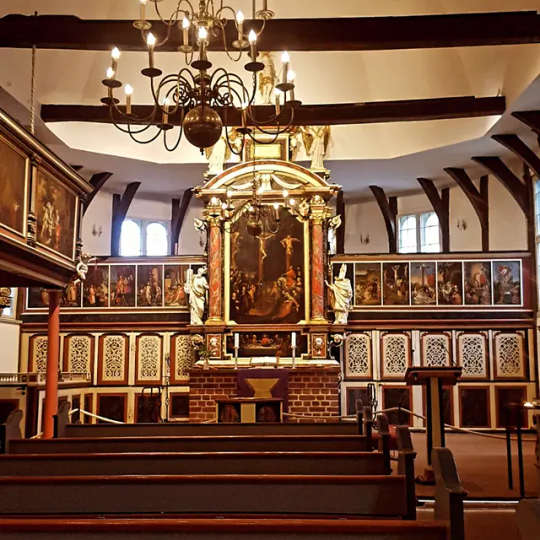


0 notes